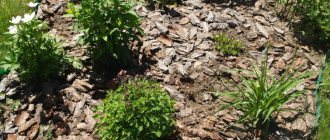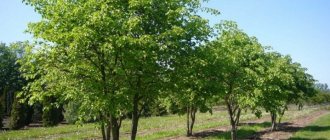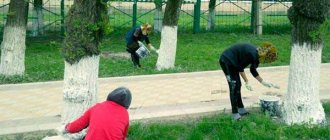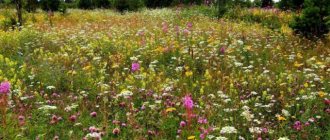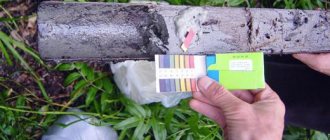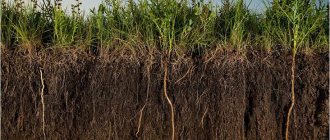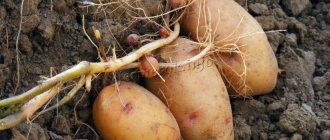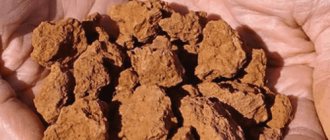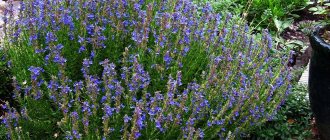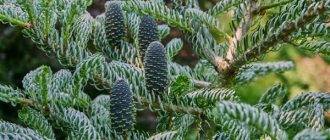What you need to know about the earth
A vegetable gardener or florist needs to have accurate information about what type of soil predominates in his garden plot, its mechanical composition, acidity level and nutrient content, as well as the presence of groundwater and its depth. Currently, methods have been developed not only for determining and improving the quality of soils already formed for lawns in a summer cottage, but also for creating completely new ones, the feature of which will be high productivity. The level of soil fertility on a site depends on the characteristics of the soil-forming process, the structure of the soil and its main characteristics.
Possession of information about methods for determining the quality of land, as well as methods for improving it, allows you to achieve high yields with minimal financial and energy costs. If the gardener decides to study the composition of the soil, then this is not so difficult, since today in agricultural practice there are many ways to determine the quality of the soil on the site, as well as how to improve its biological and chemical composition.
We determine the soil type mechanically
In order to find out what kind of soil is on the site, you can use a mechanical method. This is quite simple to do: take a handful of soil from your plot, wet it and mix until smooth. Then, roll a ball out of the ground, make a “sausage” out of it and carefully form a ring. You won’t be able to roll a “sausage” out of sandy soil and assemble it into a ring. Such soil consists of small grains of sand that do not retain moisture. In an area with sandy soil, plants will often wither and grow poorly. To improve their condition, you can add humus or peat powder to the soil. If a ball of soil is rolled up, but you cannot form a “sausage” out of it, this means that your site is dominated by soil called sandy loam. The composition and quality of sandy loam is similar to the sandy type, and therefore requires similar care. From loam you can make a ball, a rope and a ring, albeit with cracks. This type of soil absorbs moisture easily and contains many nutrients. Loam is considered fertile soil. “Plants cannot germinate normally in clay soil, but this can be corrected with the help of piercing and special fertilizing.” If the soil was easily rolled into a rope, and then into a ring without cracks, then clay soil predominates on your site. Such soil does not absorb moisture well and after rain the water remains on the surface. Sand and organic fertilizers are ideal for improving soil quality.
How does the laboratory method work?
It is important for any summer resident to know what kind of soil lies on his plot - acidic or alkaline. The laboratory method will help determine the type of soil: you only need a special solution. It can be bought at any gardening store. The kit will include a flask in which you need to place a soil sample, the solution itself and instructions for use. Once the solution is in the flask with soil, it should gradually change color. By determining the shade and reading its description in the instructions, you will find out what kind of soil is on the site and you will be able to decide on ways to improve its fertility.
How to determine the mechanical composition of the soil of a site
The constituent components of any soil are sand, clay and silt, and depending on the proportional ratio of these components, we can talk about the structure of the soil and its properties. An analysis of the mechanical composition of the soil allows one to judge the density of the soil, its air and water permeability, as well as the degree of moisture absorption. Each soil contains a certain set of nutrients necessary for the growth of a particular plant.
Depending on the mechanical composition, soil can be divided into several.
Types of soil
- Light (represented by sandy and sandy loam),
- medium (includes light loamy and medium loamy),
- heavy (heavy loamy and clayey).
Quite rare species are gravelly and rocky soils, since they can not be found very often.
Of all the variety of ways to determine the soil on a personal plot, I would like to focus on the simplest. It is necessary to take a small amount of earth and moisten it to such an extent that its consistency resembles a thick paste. After this, roll a sausage from the damp soil and try to make a ring out of it. From the results obtained, the following conclusions can be drawn.
How can you draw your own conclusions?
- With good rolling soil, high plasticity, as well as rapid folding into the desired shape and long-term preservation, we can talk about the presence of clay and heavy soil in the summer cottage.
- Good rolling of the soil into a sausage, but the formation of cracks when twisting it into a ring indicates loamy soil.
- If there is increased friability, as well as unsuccessful attempts to roll something out of the soil or roll it into shape, we can say that there is sandy or sandy loam soil in the area.
Determination of soil characteristics
Depending on our needs, or rather on the needs of the plants we want to grow, we can influence the quality of the soil in the garden by using the optimal amount of fertilizer. One of the common mistakes is fertilizing “by eye,” which can lead to unnecessary consequences. In order to reduce the risk of making a mistake, you should establish the type and characteristics of the soil on which the plants will be grown, that is, take a soil sample.
In order to get accurate results, it is best to take a soil sample and send it to a special laboratory for testing. Unfortunately, you will have to pay for such an analysis, so many people decide to determine the soil characteristics on their own. Below are tips on how you can perform simple tests yourself.
Types of soil
The first element that can be established is the soil type. It can be light, medium or heavy soil. In order to determine the mechanical composition of the soil, take a soil sample (no more than 1 teaspoon), moisten it with water and make a ball out of it. If the ball does not work out, it means that the soil is sandy. If you succeed, then roll it into a cord. Does not roll out - the soil is sandy loam. If you get a cord, try to roll it into a ring. The ring did not come out - the soil is light loamy. If the ring turns out, but cracks and breaks badly, the soil is medium loamy; the ring is slightly cracking - the soil is heavy loam. Finally, if the ring takes any shape, the soil is clayey.
You can also determine the type of soil by rubbing a handful of soil between your fingers. The table and photographs below will help you determine the characteristics of the soil.
| Soil type | Soil Features | Application in horticulture |
| The soil is heavy, clayey | After rubbing, it gets very dirty on your fingers; when wet, it can be easily sculpted (you can sculpt various shapes from it) | Rich in nutrients and moisture. Unfortunately, it is very dense, does not allow air to pass through well and is difficult to cultivate. It is not recommended to use such soil in its pure form. |
| The soil is average, sandy-clayey. | After rubbing, you feel the presence of sand, your fingers become slightly dirty; when wet, you can make thick rolls from it that are easy to tear. | It absorbs and retains water well, is moderately loose and breathable, and warms up well. It is the most fertile. |
| The soil is light and sandy. | It crumbles easily, is not plastic, does not contaminate your fingers, and cannot be sculpted even when wet. | The main advantage is good air throughput. Water does not stay in it, resulting in rapid drying. Nutrients are easily washed away. Such soil can be improved by adding organic fertilizers. |
Soil acidity
The next feature of the soil that must be established before using fertilizer is its acidity. The soil pH indicates its acidity or alkalinity. Neutral pH = 7. If the value is above 7, then this means that the soil is alkaline, and if less than 7, then the soil is acidic. The level of soil acidity affects the solubility of minerals and their availability to plants, as well as the variety and population size of organisms living in the soil. Most garden plants require soil with a pH of 6.2-6.8. However, there is a fairly large group of plants that need more acidic soil.
In order to independently establish the pH factor of the soil, you will need a special kit for conducting such studies, consisting of a test flask filled with a solution that changes color after mixing with the soil. Fill the flask with earth, the amount of which is indicated in the instructions (for example, &襴), then shake vigorously to mix with the solution. Then, you need to wait until the earth settles to the bottom of the flask and the solution turns the appropriate color. Based on the resulting color of the solution, we determine the acidity in the instructions.
Attention: the pH factor is not a constant indicator, so for research you should take several soil samples from different places in the garden. In addition, such studies should be carried out regularly, especially after artificial changes in the composition.
If it turns out that the soil is too acidic, then it can be limed or enriched with organic matter containing limestone (for example, mushroom soil). If the soil is very alkaline, you can lower the pH by adding more acidic soil or a mixture of soil with peat, or you can also use manure containing sulfur.
Plants that help determine soil type
Studying the plants growing on the site can also help in determining the characteristics of the soil. Daisies, odorless daisies and white clover grow in barren and poor soils. The appearance of these plants indicates that it is imperative to regularly fertilize with complex fertilizers.
If there is a large amount of woodlice, nettle, field mustard, small-flowered galinzoga or minuartia in the area, then this indicates that there is a lot of nitrogen in the soil. When fertilizing, then you should use only manure that lacks this element.
The appearance of horsetail, coltsfoot or creeping buttercup indicates that the soil is wet and heavy. In this case, it is recommended to loosen the soil and also mix it with sand.
Method for determining soil acidity at a site
The second most important parameter on which the yield of a garden plot depends is the acidity of the soil. There are groups of plants that will not grow in soil with a high level of acidity, and some types of vegetation adapt well to increased pH levels. Planting garden crops on a personal plot without taking into account the requirements for the level of acidity will lead to the development of various plant diseases, a slow pace of development, or complete death.
High pH levels in soils indicate a violation of nitrogen nutrition, that is, plants will receive insufficient microelements such as phosphorus, calcium and magnesium due to their low content. In addition, other compounds will have a toxic effect on the root system, and the created favorable conditions for the life of pathogenic organisms will lead to the development of various types of diseases.
DIY analysis
The most reliable and reliable way to determine soil acidity is to analyze the sample in a specialized laboratory, however, you can do it in a simpler way. A small amount of earth is taken from different points of the summer cottage and mixed together into a homogeneous mixture. A portion of soil is taken from the resulting soil for analysis, which is carried out in the following way: we place the soil in a container and, after filling it with water and thoroughly mixing, leave it for a short time so that the resulting mixture settles.
A small strip of indicator paper is dipped into the mixture and by its color one can judge the level of reaction in the area: red indicates high acidity, orange indicates medium reaction, a yellowish tint indicates weak acidity, yellow-green indicates a neutral reaction, and greenish-blue indicates alkaline soil.
Soil density at the dacha
Soil density is an indicator of the possibility of penetration not only of air and moisture, but also of the summer resident’s equipment. With increased density, it is quite difficult to work with the soil, because a shovel, pitchfork or hoe simply does not penetrate it.
Density can depend on many factors, including its content, atmospheric phenomena and general climate, geographical location, as well as the original ownership of the site. Density can be high and low, as well as normal and satisfactory. Each density affects the ability to grow certain crops on the site.
How to determine soil density yourself
In fact, this is a fairly simple process that does not require expensive equipment.
Take a glass jar with a capacity of 200-250 g and check its weight on a high-precision scale (preferably with an error of no more than 1 g). Now, pouring the topsoil from the planting site into the jar, tap the jar on your palm to compact the soil. As a result of filling, the jar should be filled to the brim. Now you need to put it in the oven for 5 hours, preheated to 100°C. This will help remove moisture from the soil.
At the end of the moisture removal period, cool the jar of soil and place it on the scale. The calculation is very simple - we calculate the density! Divide the mass of soil without a jar by the volume of the jar you took. The result is compared with the following values:
- Density, g/cm3 more than 1.5 – poor, or rather, unsatisfactory density for the largest number of plants. To reduce density, you need to add peat, up to 15-20 kg per square meter, once every 3 years.
- Density, g/cm3 1.2-1.5 – unsuitable or unsatisfactory for root crops and many vegetable crops. The situation is corrected by adding the same peat - 10-15 kg per square meter, once every 5 years.
- Density, g/cm3 1.0-1.2 – optimal for root crops, satisfactory for vegetable crops. Organic matter is added to such soil as standard.
- Density, g/cm3 less than 1.0 – optimal for vegetable crops. For this indicator, we also do not change anything and add organic matter at standard rates.
All such analyzes are repeated several times, and the arithmetic mean is taken for determination.
How can you improve the composition of the soil?
One of the simple and cheap options for improving the soil on a personal plot is to add topsoil to agricultural plots. If necessary, add sand, peat and compost to the ground in the required quantity.
Changes in the mechanical composition of the earth
Adding sawdust or sand to the soil
Which have a loosening effect. Sand can be added both before the start of the sowing campaign and after its completion. It is advisable to improve the soil composition with sawdust in the fall, and to achieve greater effect it is recommended to moisten them with a solution of nitrogen fertilizer.
Sowing green manure
Heavy soils must be sown with plants that have a strong root system and can penetrate to great depths in the ground.
Weighting
To make light soils heavier, you can use clay or silt, as well as adding certain doses of organic fertilizers in the form of manure or compost (how to make it). You should not get carried away with peat, as the myth about its beneficial properties is a little exaggerated: it does increase soil moisture and acidity, but the level of nutrients in it is minimal.
Most plants feel comfortable in soils with a neutral reaction, so the pH level in acidic soil is reduced with the help of lime, while alkaline ones, on the contrary, are acidified.
Changing the acidity of the soil
You can influence the acidity level of the soil in your summer cottage downward by adding dolomite and lime flour, chalk, and wood ash to the soil. Do not forget that it is necessary to analyze the acidity level as often as possible, since the soil reaction is constantly changing and a slow pace of plant development may indicate an emerging problem.
Mechanical composition and structure of the soil
To preliminarily determine the soil type, moisten a handful of soil and roll it into a doughnut.
- A smooth ring without cracks indicates that this is clay.
- If the donut is covered with several cracks, it is heavy loam.
- When the donut dries naturally, its surface becomes covered with many cracks - the soil is classified as medium loam.
- If the bagel breaks when rolling, you have light loam.
- If the sausage doesn’t work out, it crumbles even when rolling, instead of full-fledged soil, there is sand in front of you.
- If, when rolling, the bagel crumbles into small individual lumps - sandy loam.
To determine the level of soil structure, simply cut off a layer of soil with a shovel and throw it into the air. When falling, structured soil will crumble into individual elements - lumps, grains, etc. Heavy clay soil will fall like a pancake, while sandy soil will crumble into dust.
All of these soil types need treatment. Heavy ones will not allow water to pass through. They are practically impenetrable to air. After watering, a crust forms on such soils, and irrigation and rainwater stagnate. Plants are in constant oppression. Sandy soil will easily allow all the water to pass through, taking with it the soluble forms of applied fertilizers. Such soils must be treated before use. The main medicine is organic matter: manure (cow, horse, sheep, etc.), humus, composts. To increase the breathability and structure of heavy (clayey) soils, sawdust, finely chopped (no more than 5-6 cm) perennial grasses, shrubs, tree branches, and bark will help. It is good to add turf and forest soils to sandstones, having previously (in the fall) layered them with manure, peat, and compost. In the spring, spread it around the site and dig it up.
Soil improved with organic matter. © Em F
Treatment can be carried out in two ways:
- Do not grow anything on the plot for 2-3 years. Do only treatment. In addition to the added organic matter, during this period, occupy the area year-round with green manure, sowing and burying, when reaching a height of 8-12 cm, several times a season.
- Carry out treatment in parallel with cultivating gardens and planting fruit and berry crops. If the second method suits you better, keep in mind that you cannot use fresh manure for crops and limit its rate for autumn digging (no more than 1 bucket/sq. m). Otherwise, the sown and planted crops will burn.
Organic content in soil
Every experienced summer resident understands perfectly what organic matter is and what significance it has for the crops grown in the country.
It is very important that the organic content in the soil is not lower than a satisfactory level. Then you will not need to fertilize with high urgency and constantly worry about the fact that some seedlings do not sprout, or the harvest of certain crops does not suit you.
All organic matter in the soil is formed from the remains of plants or animals. Here, in the deep or superficial layers, decomposition occurs. Thanks to this, humus is formed.
Humus, due to its properties, improves the quality of the soil, and also increases its ability to retain moisture and microelements necessary for plant development.
How to check the amount of organic matter in the soil
A satisfactory or high amount of organic matter in the soil of a summer cottage is, in most cases, very good. But this level is worth knowing!
Often, summer residents themselves decide that the land is poor or unfertilized, and, following the advice of more experienced summer residents, they add more fertilizer. Sometimes this is beneficial, sometimes it’s the opposite, because there may be enough organic matter. And we all know that oversaturation with fertilizers is also not beneficial.
So, we need to find out the amount of organic matter in the soil. How to do it right? Let's say right away that everything is simple, except for the verification formula. If you understand it right away, then you will carry out the research itself very quickly:
- take a metal cup, pour 50 g of dry soil from the site into it and place it on the tile in a ventilated room for 3 hours;
- if there is little organic matter, there will be a little smoke, if there is a lot, the amount of smoke will increase significantly;
- after 3 hours, weigh the cup of soil on an accurate scale;
- then make the calculation. We immediately need to find out the mass of material lost when the cup is heated. We can establish it simply - subtract the mass after from the total mass of the cup with soil before calcination. We get the result. Now we multiply it by 100 and divide it by the initially loaded mass, and also subtract the static coefficient, which indicates the content of chemically bound water in the soil. For clay soils – 4, for loams – 3, for sandy loam – 2 and for sandy soils – 1.
The most basic thing remains - to assess the organic content, establish its level and find out what to do next:
- if the result is less than 2, this is a rather low content, which means that it is necessary to add up to 5 kg of manure and 10 kg of peat annually per square meter of land;
- if the value is from 2 to 3, the level is low and it is still necessary to fertilize the soil. 5 kg of manure and peat will be enough;
- a value from 3 to 6 is satisfactory, when only fertilizing with manure is necessary, about 3 kg per year;
- value more than 6 – high organic content. You can apply a small amount of manure, only 1-2 kg per square meter.
A similar assessment method is used for chernozems and soddy-podzolic soils, but is not applicable for swamp, semi-swamp, and carbonate-containing soils.
sandy soil
At what age can chickens be fed whole grains?
This is a fairly easy species that can be found in the garden. It can be defined as follows: it is loose, free-flowing. If you pour water on it, it will be absorbed almost instantly.
Sandy soil, on the one hand, quickly heats up and ventilates. On the other hand, due to its looseness, useful mineral fertilizers practically do not remain in it. It also dries quickly.
To make it more fertile, you can add peat or humus.
Why do you need to know exactly the composition of the soil?
Do you always understand why a plant has poor growth and development? Why is the zucchini harvest this year poor compared to last year? Why are the lilies so frail or have they not sprouted at all, even though they fertilized and watered them and did everything right?
We often look for reasons in bad seeds and bad weather.
Main mistake: the key reason for failure lies in the condition of the soil. Often gardeners carefully monitor the application of various fertilizers, but it does not occur to them to think about its composition and acidity.
Mother of Cheese, Earth, Nurse.
Knowing and constantly checking your soil, you can correct all your mistakes in time by correctly adjusting its composition.
Why is an acidic environment dangerous for plants?
The answer is simple: it contributes to poor absorption of nutrients and causes underdevelopment of the root system. In acidic soil, substances that are harmful to plants accumulate and the number of beneficial microorganisms decreases. The result is depletion of fertility. It is clear that without food the plant dies.
Every rule has its exceptions. Plants such as heather, tree hydrangea and rhododendrons are not afraid of acidic soils, they simply adore them.
Important: acidity changes over time under the influence of many factors (overuse of fertilizers, acid rain, addition of sand or peat, etc.).
Advice: check the acidity of the soil more often if problems arise with the formation of plants and take measures to improve it.

